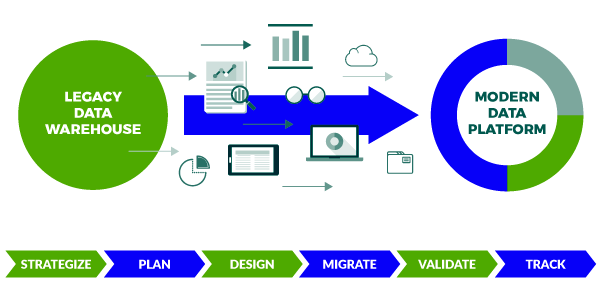HOW TO BUILD A Cost Effective DATA WAREHOUSE in 2019
Why businesses need big data?
Businesses and organizations are built with the same come purpose in mind i.e. to ensure profit maximization. Keeping track of each item available in the inventory to the recent sales figures, these companies want everything single thing to be kept recorded and later utilized in the most efficient way whenever needed. This accumulation of huge data from everyday transactional to managing activities takes the form of Big Data and now companies want a fast, quick and efficient way to manage their big data using the latest BI tools.
What is data warehousing?
One such technique is called Data warehousing which is considered to be a dream of every business analyst because it gives such tremendous power to analyze data within seconds and conclude extremely useful information from it to make intelligent business decisions. On the same concept, a data warehouse is a large storage area of big data, with data coming from a wide range of sources and is used to guide managing directors in critical decision making.
What points do I need to know about data warehousing before building my own data warehouse?
To improve corporate profits and overall business performances, Data warehouses are mostly used to associate big business data towards providing better executive insights. Data warehouses are greatly different from ordinary databases. Because the normal databases are mostly focused on updating the real-time data with a greater focus on achieving accuracy and precision, however, a data warehouse gives a long-range extensive view of the data over a period of time. This gives a big picture of the company’s overall performance in the last 5-10 years and which steps should be taken to improve those results.
Why companies face difficulty in building a data warehouse?
Data warehouse implementation techniques are highly technical and are not cost –effective. It requires a good budget and a flexible time schedule to implement otherwise it gets too chaotic with the company’s data gathering process. Another issue companies face is that data warehouses do not excel at unstructured or raw data. And because of the budget issue, it becomes almost a dream to implement a data warehouse for small businesses.
How long does it take to build a data warehouse?
If someone has hired expert data analysts and are following all the right, cost-effective and efficient techniques then it may take 6-8 weeks otherwise the process gets a little longer.

Data Warehouse Implementation Steps
Let us see what are some of the points that we need to keep in mind before building a cost-effective data warehouse in 2019:
-
Determining your own business objectives
The first step towards building a data warehouse from scratch includes a thorough understanding of the company’s goal, mission, vision, its future plans, its target audience, financial reports, qualitative and quantitative success determining factors, etc. All these points jointly give a better understanding of the business itself. Suppose the managers want to make a big decision about hiring the new employees for a certain product, now before they start doing the interview processes, they need to better analyze the overall business, whether this decision of hiring new people will be beneficial for the long run for this particular business or not, whether we should adapt technique A or go for technique B, each and every decision requires a complete in-depth understanding of the business model.
-
Gathering the information
Next step is to gather as much data as possible, because the bigger the data is the better predictions it gives for the future. You can collect information about some particular activity or idea by taking surveys, filling questionnaires, interviews, observations, you can also gather data from company’s financial reports, Customer relationship management solutions or other related tools, etc. All these mediums can prove extremely beneficial in gathering a sound, accurate and wide variety of useful information.
-
Analyzing the information
This is considered to be a big problem for data warehouse designers about how they analyze the information being gathered. To minimize any ambiguity in the prices, they need to be frequently in close connections with the people involved in the process, so they can understand the activities in detail and interpret the information rightly.
-
Identifying the core activities involved
By this point, you must have a very clear understanding of what your business is about. Now you have to identify the key performance indicators just like a total number of sales, revenue generated in the last 6 months, total employees hired, etc. In this phase you need to identify the core business activities involved in your organization, e.g you want to conduct training for the employees of a certain division, your business needs to hire a new employee or have launched a new product line, we need to identify the entities involved towards creating the key performance indicators.
-
Locating data sources
How to choose a data warehouse depends upon what you want from it to get done for you. Data warehouse designers work closely with the people involved in the business processes to gather accurate data which can help in giving accurate predictions towards future decisions. As discussed earlier, information can be gathered from sources like CRM tools, employee’s data records, surveys, questionnaires, etc. Now we have to all this information into a structured, detailed database format to be entered into the data warehouse. We need to move the data from these tools to the data warehouse in a systematic way to minimize any installation errors.
-
Implementing the plan
After developing the complete plan, now is the time to implement it. By estimating a proper timeline, setting the scope of the project we can start implementing the data structures into the system. Every new data structure will be added next to the previous one and will be connecting like the dots of a picture, and will keep on adding value to the system incrementally. Once done, our data warehouse is ready to help us toward guiding in critical decision making.

Thank you so much. At last, I found an article which I am searching for a long time.
I hope it will help me .
Best regards,
Lunding Zacho
Thank you
I read a lot of posts here. Probably you spend a lot of time
writing, Thanks!
Best regards,
Mead Hessellund
Thank you
I’m pleased with the information that you provide for me and thanks for this because sometimes people face this problem.
Best regards,
Harrell Valenzuela
Thank you for taking the time.
King regards,
Thomassen Valenzuela
I randomly stopped by your site but you are really successful Liana Basile Elnora
Thank you ever so for you blog article. Thanks Again. Really Great. Berna Allyn Olli Kym Duffy Jodee
Incredible points. Great arguments. Keep up the good work. Georgianne Cheston Davis
I truly appreciate this article post. Really looking forward to read more. Awesome. Melonie Farly Dennett
Everything is very open with a really clear explanation of the challenges. It was definitely informative. Your site is extremely helpful. Many thanks for sharing!
Heya i am for the first time here. I found this board and I find It truly useful & it helped me out a lot. I hope to give something back and help others like you aided me.| Sharl Gayle Kirk
Hello there. I found your site via Google even as looking for a related matter, your web site got here up. It seems great. I have bookmarked it in my google bookmarks to visit then. Cristionna Karlan Grayson
Thank you for the good writeup. It in fact was a amusement account it. Look advanced to more added agreeable from you! However, how can we communicate? Harriet Sidney Kotto
Hey, thanks for the blog article. Really thank you! Really Great. Stephi Abran Hulbard
Good response in return of this difficulty with solid arguments and describing everything concerning that.
It warms my heart to read your words. I look forward to reading more.
A round of applause for your blog. Much thanks again. Cool. Lynelle Marlon Montagna
I truly appreciate this post. I have been looking everywhere for this! Thank goodness I found it on Bing. You have made my day! Thx again..
I got what you intend,bookmarked, very decent website.
As a Newbie, I am always searching online for articles that can aid me. Thank you
Just desire to say your article is as astonishing. The clarity in your post is simply cool and i can assume you are an expert on this subject. Well with your permission let me to grab your RSS feed to keep up to date with forthcoming post. Thanks a million and please keep up the gratifying work.